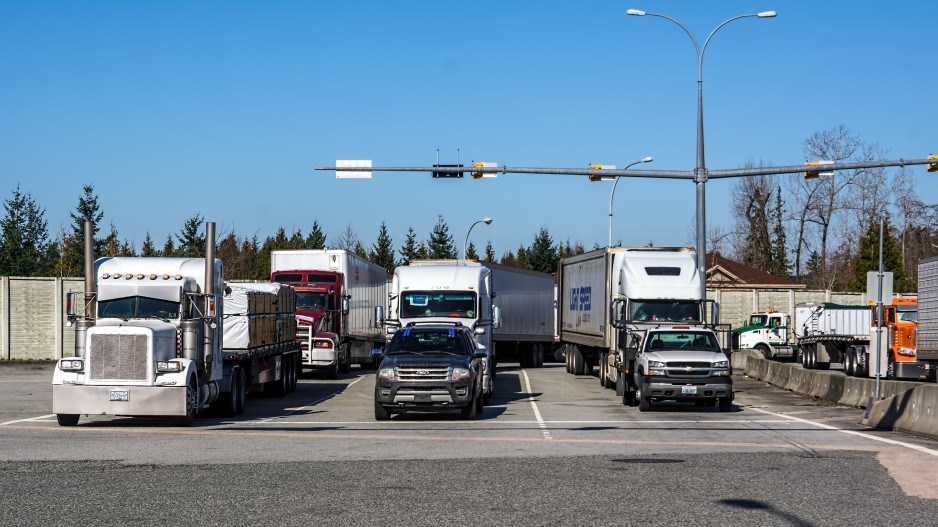When the United States sneezes, Canada catches a cold. And while British Columbia is less exposed to the U.S. than other provinces, it can’t recover economically from COVID-19 when its largest trading partner is still fighting off the virus.
“There won’t be a recovery to speak of unless the U.S. economy also regains some momentum,” said Jock Finlayson, executive vice-president and chief policy officer at the Business Council of British Columbia (BCBC).
Roughly half of B.C.’s exports flow south. Before the provincial pandemic peaked and the U.S. crisis intensified, the value of U.S.-bound exports was unchanged year-over-year in March.
By comparison, B.C. exports to Western Europe fell by nearly 34% the same month, and exports to Mainland China – B.C.’s second-largest trading partner – were down by close to 39%.
But the B.C.-U.S. economic picture has changed.
International tourism has collapsed, and with it, the nearly 11,000 U.S. overnight visits a day B.C. clocked in 2019.
The film and television sector, also driven by American dollars, has effectively been cancelled. The movement of people across the border – critical for certain sectors, including B.C.’s highly connected high-tech sector – remains challenged.
Finlayson said analysts are forecasting a third- and fourth-quarter U.S. recovery that continues into 2021. But if one of the world’s largest buyers and producers of goods and services doesn’t reboot, B.C. and Canada’s recovery will be sub-par.
“If there isn’t any appreciable recovery in the U.S. ,and the economy sort of stagnates, then obviously there won’t be a recovery here. It’s that simple,” Finlayson said.
The chief economist of Goldman Sachs Group, Inc. (NYSE:GS) recently commented that the firm expects U.S. growth to decline 39% in the second quarter on a quarter-to-quarter annualized basis. A 29% increase in the third quarter and an 11% increase in the fourth are also forecasted.
Canada’s economic performance typically follows what happens south of the border.
“It’s not that far from one-to-one. We are closely correlated with U.S. economic activity,” said James Brander, a professor in the strategy and business economics division at the University of British Columbia’s Sauder School of Business. The correlation exists because Canada is directly affected by both what happens in the U.S. and by the same macroeconomic forces that affect its southern neighbour.
“Both those things are important with COVID,” Brander said. “It’s not a perfect correlation, and it depends on the source, but it’s pretty darn close.”
Because what B.C. has gone through is so extreme, Finlayson said the partial re-opening of B.C.’s economy this week will produce some benefits. In a sense, he said, “it couldn’t get any worse.”
But benefits will not make up for global economic issues and will not be spread evenly across all corners of the economy.
B.C.-based, U.S.-focused manufacturers that produce goods for certain industries – such as specialized equipment for use in restaurants – will continue to struggle if their customers remain closed.
“It’s critical that the economies recover together. But it’s global, not just the U.S.,” said Andrew Wynn-Williams, B.C. divisional vice-president of the Canadian Manufacturers & Exporters (CME).
“If there’s no global recovery, then we’re equally going to be in trouble.”
It’s not only a market access issue, but a production issue. Hardened borders, forced business closures and new health protocols have disrupted the deep supply chain integration that makes North America a manufacturing machine.
“It’s so interrelated that without a global recovery, our manufacturing platform can’t recover, and if one piece isn’t working, then the other piece isn’t working.”
According to a recent CME report, B.C.’s economy is forecast to contract by 8.2% this year, with growth weighed down by declining global trade volumes and slower activity at B.C. ports.
“It’s not going to be normal until there’s a vaccine,” said Anil Hira, a professor of political science at Simon Fraser University, adding that high unemployment means less consumer confidence around spending or engaging certain services.
“All these kinds of person-to-person services are going to take a long, long time to come back regardless of how much money the government pumps into the economy.”
That affects domestic spending, as well as spending by U.S. consumers on certain kinds of services in sectors such as tourism.
Hira pointed to other challenges facing the B.C. and Canadian economies. Weak oil prices have hurt Alberta, which will in turn hurt Alberta’s contributions to federal coffers that can also expect lower revenues from certain forms of taxation. Billions in survival spending will place a debt burden on a generation that will also bear the costs of climate change and automation. Affordability remains a concern, as does Canada’s skills shortage and its relatively weak ability to scale companies.
Hira said he’s concerned about how Canadians in their 20s will be able to secure the middle-class lifestyle enjoyed by the generation before them.
“Does the government really have the tools on hand to solve this problem? In the short run they can provide relief, but they can’t really solve the problem.”
In March, BCBC published two economic scenarios for the province. The first estimated a contraction of around 7%, and the second, a contraction of just over 11%.
The council will publish a revised economic outlook in June. Contraction estimates are expected to be deeper. •




